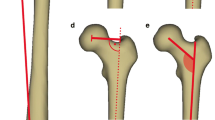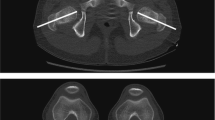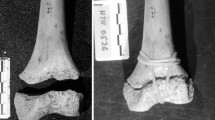Abstract
Background
Biplanar x-ray images obtained with patients in a standing weightbearing position allow reconstruction of three-dimensional (3-D) bone geometries, with lower radiation exposure than CT scans and better bone definition than MRI.
Questions/Purposes
We determined the reproducibility of 3-D parameter values of the hips and pelves of healthy children, using biplanar x-ray images.
Methods
We built 3-D models of the hips of 33 children without musculoskeletal problems: 10 subjects younger than 9 years and 23 who were 9 years or older. Three anatomic landmarks and nine hip and pelvic parameters were computed for each reconstruction. To determine the reliability of these landmarks and parameters, each bone was reconstructed four times by two independent observers, leading to a total of 264 reconstructions, and parameters were studied for the two age groups and compared between dancers and nondancers.
Results
Taking into account all reconstructions, the interobserver reproducibility ranged from 2 to 4 mm for landmark positions or distance parameters, and 2° to 6° for angular parameters. The most reproducible point was the center of the femoral head (range, 0.2–17 mm). The distance between this center and its projection on the plane fitting the edge of the acetabulum, and the pelvic tilt were the most reproducible parameters.
Conclusions
Reproducible 3-D reconstructions of hips and pelves of children were possible using biplanar x-ray images, regardless of the children’s ages. Although we report preliminary values for 3-D parameters in healthy children’s hips, further work is needed to obtain direct validation of our parameters using CT reconstructions of cadaveric specimens to avoid high doses of radiation.



Similar content being viewed by others
References
Baudouin A, Skalli W, de Guise JA, Mitton D. Parametric subject-specific model for in vivo 3D reconstruction using bi-planar X-rays: application to the upper femoral extremity. Med Biol Eng Comput. 2008;46:799–805.
Broughton NS, Brougham DI, Cole WG, Menelaus MB. Reliability of radiological measurements in the assessment of the child’s hip. J Bone Joint Surg Br. 1989;71:6–8.
Chaibi Y, Cresson T, Aubert B, Hausselle J, Neyret P, Hauger O, de Guise JA, Skalli, W. Fast three-dimensional reconstruction of the lower limb using a parametric model and statistical inferences and clinical measurements calculation from biplanar X-rays. Comput Methods Biomech Biomed Engin. 2012;15:457–466.
Champain S, Benchikh K, Nogier A, Mazel C, De Guise JA, Skalli W. Validation of new clinical quantitative analysis software applicable in spine orthopaedic studies. Eur Spine J. 2006;15:982–991.
Cirotteau Y. [Correlations between the bony structures of the hip][in French]. Rev Chir Orthop Reparatrice Appar Mot. 1982;68:14–19.
Dandachli W, Kannan V, Richards R, Shah Z, Hall-Craggs M, Witt J. Analysis of cover of the femoral head in normal and dysplastic hips: new CT-based technique. J Bone Joint Surg Br. 2008;90:1428–1434.
Dubousset J, Charpak G, Dorion I, Skalli W, Lavaste F, Deguise JA, Kalifa G, Ferey S. [A new 2D and 3D imaging approach to musculoskeletal physiology and pathology with low-dose radiation and the standing position: the EOS system][in French]. Bull Acad Natl Med. 2005;189:287–297; discussion 297–300.
Inan M, Senaran H, Mackenzie WG. Center of the femoral head: a magnetic resonance imaging study. J Pediatr Orthop. 2006;26:471–473.
Lude L, TaillardW. [Development of articular congruence of the hip in children (study of a radiologic profile)][in French]. Rev Chir Orthop Reparatrice Appar Mot. 1964; 50: 757–777.
Mac-Thiong JM, Berthonnaud E, Dimar JR 2nd, Betz RR, Labelle H. Sagittal alignment of the spine and pelvis during growth. Spine (Phila Pa 1976). 2004;29:1642–1647.
Mac-Thiong JM, Labelle H, Berthonnaud E, Betz RR, Roussouly P. Sagittal spinopelvic balance in normal children and adolescents. Eur Spine J. 2007;16:227–234.
Matthews BL, Bennell KL, McKay HA, Khan KM, Baxter-Jones AD, Mirwald RL, Wark JD. Dancing for bone health: a 3-year longitudinal study of bone mineral accrual across puberty in female non-elite dancers and controls. Osteoporos Int. 2006;17:1043–1054.
Mitton D, Deschênes S, Laporte S, Godbout B, Bertrand S, de Guise JA, Skalli W. 3D reconstruction of the pelvis from bi-planar radiography. Comput Methods Biomech Biomed Engin. 2006;9:1–5.
Murray RO, Duncan C. Athletic activity in adolescence as an etiological factor in degenerative hip disease. J Bone Joint Surg Br. 1971;53:406–419.
Pouletaut P, Claude I, Winzenrieth R, Ho Ba Tho MC, Sebag G. Automated analysis of MR image of hip: geometrical evaluation of the Legg-Calve-Perthes disease. Med Eng phys. 2005;27: 415–424.
Siebenrock KA, Ferner F, Noble PC, Santore RF, Werlen S, Mamisch TC. The cam-type deformity of the proximal femur arises in childhood in response to vigorous sporting activity. Clin Orthop Relat Res. 2011;469:3229–3240.
Tönnis D. Normal values of the hip joint for the evaluation of X-rays in children and adults. Clin Orthop Relat Res. 1976;119:39–47.
Vialle R, Levassor N, Rillardon L, Templier A, Skalli W, Guigui P. Radiographic analysis of the sagittal alignment and balance of the spine in asymptomatic subjects. J Bone Joint Surg Am. 2005;87:260–267.
Acknowledgments
We thank B. Sandoz PhD for his involvement in the data collection protocol. We also thank V. Vasta for the 3-D reconstructions and C. Fedelich and T. Bellot MD for technical support.
Author information
Authors and Affiliations
Corresponding author
Additional information
The Laboratoire de Biomecanique, Arts et métiers Paristech has received funding from the Agence Nationale pour la Recherche (ANR, Paris, France) (project SECUR_ENFANT_06_0385) and by MEDICEN (Paris, France).
All ICMJE Conflict of Interest Forms for authors and Clinical Orthopaedics and Related Research editors and board members are on file with the publication and can be viewed on request.
Clinical Orthopaedics and Related Research neither advocates nor endorses the use of any treatment, drug, or device. Readers are encouraged to always seek additional information, including FDA-approval status, of any drug or device prior to clinical use.
Each author certifies that his or her institution approved the human protocol for this investigation, that all investigations were conducted in conformity with ethical principles of research, and that informed consent for participation in the study was obtained.
This work was performed at Arts et Métiers Paristech, Paris, France.
About this article
Cite this article
Rampal, V., Hausselle, J., Thoreux, P. et al. Three-dimensional Morphologic Study of the Child’s Hip: Which Parameters Are Reproducible?. Clin Orthop Relat Res 471, 1343–1348 (2013). https://doi.org/10.1007/s11999-012-2660-5
Received:
Accepted:
Published:
Issue Date:
DOI: https://doi.org/10.1007/s11999-012-2660-5




